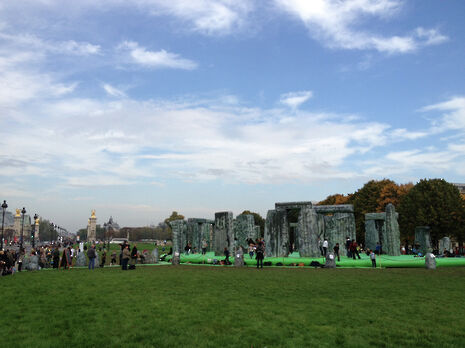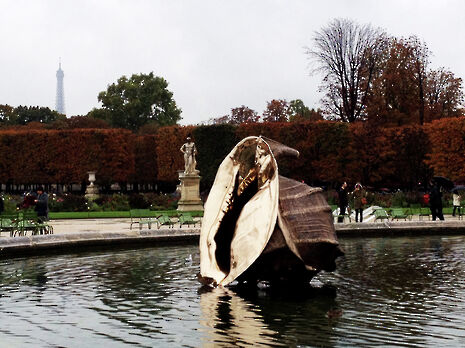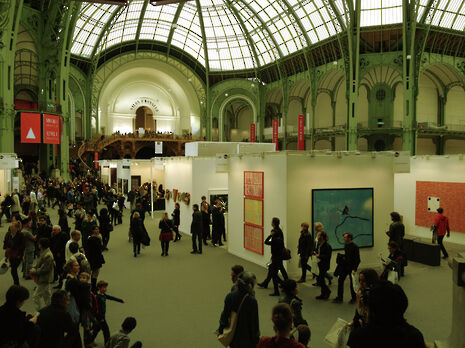What the FIAC
Emily Fitzell explores the Parisian art scene. Via bouncy castles

It’s not every Sunday afternoon you get to gambol about on a bouncy castle shaped like Stonehenge – especially not once you’ve hit twenty. But on this fine, unseasonably scorching October Sunday, to the wailing objections of a mounting pile of essays and errands, that’s exactly what I went and did. I will plead my case accordingly- FIAC’s been in town.
FIAC, the prestigious International Contemporary Arts Fair, today began to wrap up its ubiquitous three-day takeover of Paris. Its main spectacle, held at the Grand Palais, has this weekend showcased works from a mammoth 178 galleries and 2867 artists, whilst an accompanying series of outdoor art projects have been scattered hors des murs about the city for the amusement of the general public. One such installation, the inflatable spectacle Sacrilege by British artist Jeremy Deller, became the site of my ebulliently enthusiastic somersaults earlier on today.

FIAC provided something for everyone this weekend: with various options stretching the length of the Seine, I hopped from the expo full of chequebook-choking collectors’ items to free film screenings, live art at the Louvre, a sculpture series in the Tuileries Garden and various child (and adult) friendly interactive installations.
But FIAC isn’t the whole story. In fact, the entire month of October has been one big arty party here in Paris. Only the weekend before last, doors were opened and ticket barriers raised as Paris went nocturnal for the 11thcelebration of the annual Nuit Blanche, an all-night art festival which sees free entry to the city’s major museums combined with star-lit street entertainment. As I stole an early-morning glance back down at the city’s artistic bout of mass insomnia from the top of the Institut Monde Arabe, I found myself appreciating for the first time the full implications of the French exception culturelle.
When it comes to the arts, France is famous worldwide for its tradition of heavy state patronage. Dating back to ceremonial commissions made by 16thcentury kings, it’s been an established feature of French culture for as long as they’ve been eating Frogs Legs- and a more enduring one at that.
However, despite regular days devoted to art, free museum entry for all on the first Sunday of every month (constant free access for EU students), and a government which continues -despite the current climate- to plough money into new exhibition spaces, teaching, and large public commissions, the question of the accessibility of the art world in Paris still remains a contentious one among cynics in today’s Fifth Republic.
Back at the bouncy castle, a blurb by Mr Deller declared that the aim of his springy Stonehenge scene was to “empower the creativity of the masses” by making something interactive and accessible to all. Interactive, and accessible to all, he proclaimed… So shoes off, I leapt about with my inner child in hand, spotting the Grand Palais dart in and out of view above the comically lofty inflatable pillars. Yet with each new sighting, I found myself ensnared by the adult grasp of gravity; I was brought sinking back to earth by the consideration of the steep fees I had paid in order to visit the main exhibition the previous day, and the fact that due to the rather hefty price tag, others I knew had been deterred.

This visual stage-off between the free, inclusive installation I was sat on and the exclusive reception which I knew was secreted inside the Grand Palais forced me to think of the ‘options’ and ‘variety’ of the festival -as I had been considering them all weekend- instead, like others I have spoken to, as some sort of financial or social divide. The bouncy castle may well have been free, but the elite world of high-end artwork remained locked away from the general public, out of sight within the confines of costly fees, VIP signs and militant-looking men adorned by foreboding high-vis glad rags.
Alas, it would seem that the Euro too is a double-sided coin. Critics of the Parisian art world bemoan the elitism of boutique galleries and the growing commercialisation of the industry, and see state patronage as a mere attempt to resuscitate the nation’s flailing rep on the contemporary global scene. This said, I think I prefer to see endeavours such as FIAC in terms of the evident effort made to include the masses in events which could quite easily be entirely exclusive. Compare FIAC , for instance, to London’s Frieze Art Fair which also took place this month- did anyone outside Regents Park hear a peep? And with so many other city events run on full subsidy for the general public throughout the year, I fail to see how the steps taken by the state benefit anyone more than the Parisians themselves.
Flout the cynics. The popularity, variety and inclusivity of Paris’ numerous art events is commendable, and as far as my own experiences have shown me, unparalleled. The city’s art scene embellishes its already exquisite architecture with new life and constant visual surprise; and now complete with its own portable bouncy castle, it certainly lends a whole new meaning to Ernest Hemingway’s vision of Paris as ‘a moveable feast’.
For more information:
FIAC: http://www.fiac.com/
Nuit Blanche Paris: http://nuitblanche.paris.fr/
Sacrilege 2012: http://sacrilege2012.co.uk/
 Comment / Plastic pubs: the problem with Cambridge alehouses 5 January 2026
Comment / Plastic pubs: the problem with Cambridge alehouses 5 January 2026 News / Cambridge academics stand out in King’s 2026 Honours List2 January 2026
News / Cambridge academics stand out in King’s 2026 Honours List2 January 2026 News / Cambridge businesses concerned infrastructure delays will hurt growth5 January 2026
News / Cambridge businesses concerned infrastructure delays will hurt growth5 January 2026 News / AstraZeneca sues for £32 million over faulty construction at Cambridge Campus31 December 2025
News / AstraZeneca sues for £32 million over faulty construction at Cambridge Campus31 December 2025 Interviews / You don’t need to peak at Cambridge, says Robin Harding31 December 2025
Interviews / You don’t need to peak at Cambridge, says Robin Harding31 December 2025










